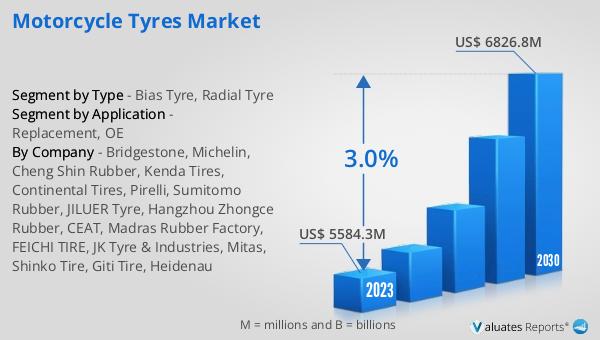What is Global Motorcycle Tyres Market?
The global motorcycle tyres market is a dynamic and evolving sector that plays a crucial role in the automotive industry. Motorcycle tyres are specifically designed to meet the unique demands of two-wheeled vehicles, providing the necessary grip, stability, and performance required for safe and efficient riding. This market encompasses a wide range of tyre types, including bias and radial tyres, each catering to different riding conditions and preferences. The growth of the global motorcycle tyres market is driven by factors such as increasing motorcycle sales, rising demand for fuel-efficient and eco-friendly vehicles, and advancements in tyre technology. Additionally, the market is influenced by regional trends, consumer preferences, and regulatory standards. As motorcycles continue to be a popular mode of transportation worldwide, the demand for high-quality and durable tyres is expected to remain strong. Manufacturers are constantly innovating to develop tyres that offer improved performance, safety, and longevity, catering to the diverse needs of motorcycle enthusiasts and commuters alike. The global motorcycle tyres market is poised for steady growth, with opportunities for expansion in emerging markets and a focus on sustainable and technologically advanced products.

Bias Tyre, Radial Tyre in the Global Motorcycle Tyres Market:
Bias tyres and radial tyres are two primary types of tyres used in the global motorcycle tyres market, each with distinct characteristics and applications. Bias tyres, also known as cross-ply tyres, have a construction where the ply cords are arranged diagonally from bead to bead, typically at angles of 30 to 40 degrees. This design provides a robust and durable structure, making bias tyres suitable for off-road and heavy-duty applications. They offer excellent load-carrying capacity and are less susceptible to damage from rough terrains, making them a popular choice for adventure and touring motorcycles. Bias tyres also tend to be more affordable than radial tyres, which can be an important consideration for cost-conscious consumers. However, they may not provide the same level of ride comfort and handling precision as radial tyres, especially at higher speeds. On the other hand, radial tyres feature a construction where the ply cords are arranged at a 90-degree angle to the direction of travel, with additional layers of steel or fabric belts running circumferentially. This design allows for a more flexible sidewall and a larger contact patch with the road, resulting in improved grip, stability, and ride comfort. Radial tyres are known for their superior performance on paved roads and are often preferred for sport and high-performance motorcycles. They offer better heat dissipation, which enhances their longevity and performance at high speeds. However, radial tyres can be more expensive than bias tyres, and their softer sidewalls may be more prone to damage in off-road conditions. The choice between bias and radial tyres depends on various factors, including the type of motorcycle, riding style, and intended use. While bias tyres remain popular for their durability and cost-effectiveness, radial tyres are gaining traction due to their superior performance characteristics. As the global motorcycle tyres market continues to evolve, manufacturers are focusing on developing innovative tyre technologies that combine the best features of both bias and radial designs, offering riders enhanced safety, performance, and versatility.
Replacement, OE in the Global Motorcycle Tyres Market:
The global motorcycle tyres market serves two primary areas of usage: replacement and original equipment (OE). The replacement segment is the largest application area, accounting for a significant share of the market. This segment involves the sale of tyres to replace worn-out or damaged tyres on existing motorcycles. The demand for replacement tyres is driven by factors such as the increasing number of motorcycles on the road, the need for regular maintenance, and the desire for improved performance and safety. Motorcycle owners often seek replacement tyres that offer better grip, durability, and fuel efficiency, leading to a steady demand for high-quality products. The replacement market is also influenced by consumer preferences, with riders opting for tyres that suit their specific riding conditions and styles. On the other hand, the original equipment (OE) segment involves the supply of tyres to motorcycle manufacturers for installation on new vehicles. This segment is closely tied to the production and sales of new motorcycles, with tyre manufacturers collaborating with OEMs to develop tyres that meet specific performance and safety standards. The OE market is driven by factors such as technological advancements, regulatory requirements, and the introduction of new motorcycle models. Tyre manufacturers in the OE segment focus on innovation and quality to meet the stringent demands of motorcycle manufacturers and consumers. Both the replacement and OE segments are essential to the growth of the global motorcycle tyres market, with each offering unique opportunities and challenges. As the market continues to expand, manufacturers are investing in research and development to create tyres that cater to the evolving needs of both segments, ensuring optimal performance, safety, and sustainability.
Global Motorcycle Tyres Market Outlook:
The global motorcycle tyres market was valued at approximately $5,863 million in 2024 and is anticipated to grow to a revised size of around $7,204 million by 2031, reflecting a compound annual growth rate (CAGR) of 3.0% over the forecast period. Within this market, bias tyres represent the largest product segment, accounting for about 55% of the market share. This dominance is attributed to their affordability and durability, making them a preferred choice for many riders, especially those who frequently navigate rough terrains or require tyres with high load-carrying capacity. In terms of application, the replacement segment holds the largest share, also at about 55%. This significant share underscores the ongoing demand for replacement tyres as motorcycle owners seek to maintain or enhance the performance and safety of their vehicles. The replacement market's prominence is driven by the increasing number of motorcycles in use, necessitating regular tyre replacements due to wear and tear. As the market evolves, manufacturers are focusing on developing innovative products that meet the diverse needs of consumers, ensuring sustained growth and competitiveness in the global motorcycle tyres market.
| Report Metric | Details |
| Report Name | Motorcycle Tyres Market |
| Accounted market size in year | US$ 5863 million |
| Forecasted market size in 2031 | US$ 7204 million |
| CAGR | 3.0% |
| Base Year | year |
| Forecasted years | 2025 - 2031 |
| by Type |
|
| by Application |
|
| Production by Region |
|
| Consumption by Region |
|
| By Company | Bridgestone, Michelin, Cheng Shin Rubber, Kenda Tires, Continental Tires, Pirelli, Sumitomo Rubber, JILUER Tyre, Hangzhou Zhongce Rubber, CEAT, Madras Rubber Factory, FEICHI TIRE, JK Tyre & Industries, Mitas, Shinko Tire, Giti Tire, Heidenau |
| Forecast units | USD million in value |
| Report coverage | Revenue and volume forecast, company share, competitive landscape, growth factors and trends |
